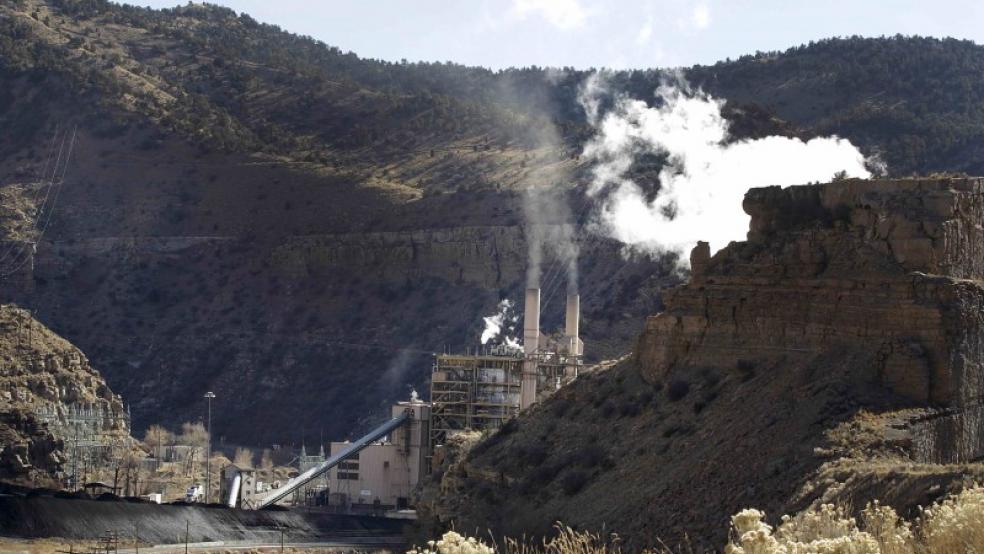President Trump frequently touts what he sees as the economic benefits of eliminating Obama-era clean air regulations to revive the struggling coal industry and put more miners back to work. Trump is pressing to scale back Environmental Protection Agency restrictions on emissions from coal-fired power plants that were designed to combat climate change and reduce health-threatening fine-particle emissions.
On March 28, Trump signed an executive order designed to roll back federal regulations on carbon emissions, including former President Obama’s signature Clean Power Plan that sought to reduce greenhouse gas emissions from coal-fired power plants and lift a moratorium on new coal leases on public lands. He also pulled the U.S. out of the 2015 international Paris Accord aimed at sharply reducing carbon emissions.
Related: Trump Suffers a Rare Setback in War on Environmental Protection
“The miners told me about the attacks on their jobs and their livelihoods,” Trump said as he signed the order at EPA headquarters. “They told me about the efforts to shut down their mines, their communities and their very way of life. I made them this promise. We will put our miners back to work.”
Trump’s near obsession with trying to prop up a dying coal industry that has been supplanted by natural gas producers and other alternative fuels almost completely ignores the harsh toll his policies will have on public health and ever-rising health care costs.
The grim reality is that even under Obama’s aggressive efforts to combat air pollution, tens of thousands of mostly older Americans are dying unnecessarily every year because carbon emission levels are still way to high.
Air pollution causes an estimated 200,000 early deaths in the U.S. annually, according to a 2013 national study by the Massachusetts Institute of Technology (MIT) Laboratory for Aviation and the Environment. Emissions from cars and trucks were the most significant contributor, causing 53,000 premature deaths, closely followed by coal-fired power plants, with 52,000 deaths.
Related: Trump’s Rollback on Clean Air and Water Rules Could Raise Health Care Costs
Those premature deaths come with a huge price tag that the government and society are paying for in myriad ways because of the adverse effects of air pollution on millions of Americans across the country.
Air pollution generated by energy production was responsible for at least $131 billion in damages due to deaths, sickness, hospitalization and lost productivity in 2011 alone, according to an analysis published last year in the journal, Energy Policy. That was down from annual totals as high as $175 billion in the past decade – but that number can rise again under Trump’s deregulation and budget cuts to EPA.
A new report from the Harvard T.H. Chan School of Public Health released Wednesday concluded that while the Obama administration and many state officials made important strides in recent years in reducing harmful emissions, even a slight increase in existing standards would save thousands of more lives every year.
The Clean Air Act authorizes the EPA to protect the public health by regulating the emissions of harmful air pollution – primarily smog and soot generated by burning fossil fuels. The tiniest airborne particles in soot – known as PM 2.5 – are especially dangerous because they penetrate lungs and blood streams and worsen bronchitis. Inhalation of those tiny particles can lead to heart attacks and even death, especially among older people, public health experts report.
The Harvard researchers correlated 12 years of health care records of more than 60 million Medicare beneficiaries with specific air quality levels to reduce the death rate linked to bad air quality.
The study found that long-term exposure to ozone and PM2.5 increases the risk of premature death, even when the exposure is at levels below current EPA national ambient air quality standards. Men, blacks, and low-income people had higher risks of premature death from PM2.5 exposure, the study found, with African-Americans three times as likely to die prematurely.
Related: Environmentalists’ Worst Fears About Trump Are Coming True
Between 2000 and 2015, the average concentrations of PM 2.5 pollution nationwide declined by 37 percent, largely because of tougher rules and stricter EPA enforcement, according to the new study.
The Harvard researchers concluded that if levels of fine particulate matter could be lowered again by just one microgram per cubic meter, about 12,000 lives could be saved each year. In similar fashion, about 1,900 lives a year could be saved by lowering ozone by just 1 part per billion nationally.
Conversely, the data showed that the death rate went up 7.3 percent for every increase of 10 micrograms in small-particle pollution – the equivalent to about 120,000 fatalities among Americans 65 and older. At the same time, the mortality rate rose by 1.1 percent for every 10 parts-per-billion rise in ozone concentration, resulting in an additional 19,000 deaths among the elderly.
In other words, serious backsliding by the EPA and the Trump administration in the enforcement of the Clean Air Act and other climate control policies could have a deadly impact on many Americans, especially seniors and younger people with asthma and other respiratory illnesses.
Related: Americans Are Having Doubts About Trump’s Agenda: Poll
Francesca Dominici, a professor of biostatistics at Harvard and a senior author of the study, told Reuters Health yesterday that she hoped the findings "will change the course of recent discussions about dismantling EPA and EPA research and leaving the Paris agreement.”
The study sought to place a monetary value on the adverse health effects caused by air pollution to come with a total “social cost” of the emissions. Paulina Jaramillo, an assistant professor of public policy at the Carnegie Mellon University who led the research, told The Washington Post that “The bulk of the cost of emissions is the result of health impacts” and deaths.





